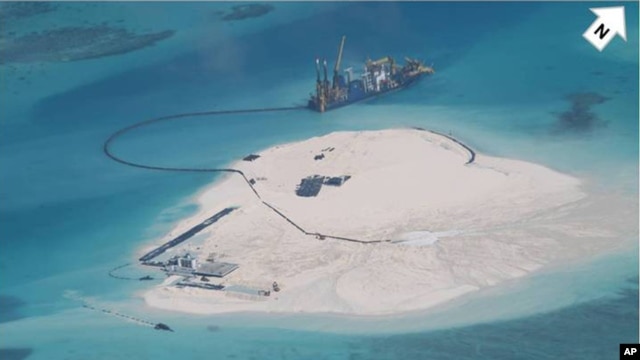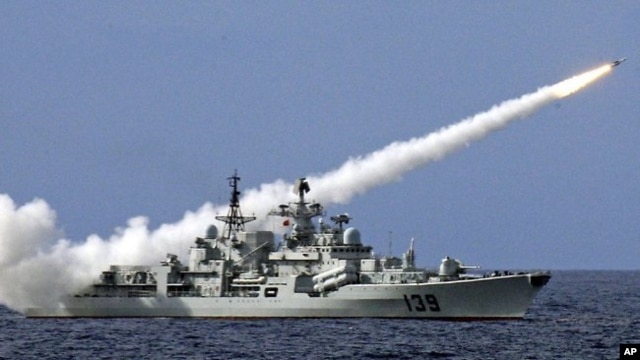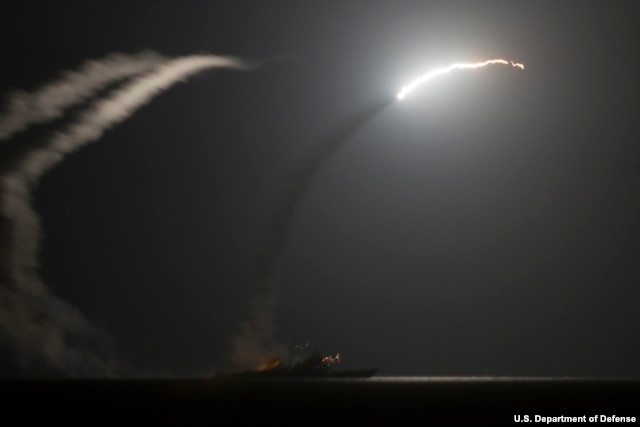US to Continue Patrols Despite South China Sea Missile Deployment
FILE - A Chinese vessel, top center, is used to expand structures and land at the Spratly Islands in the South China Sea in this Feb. 25, 2014, photo. U.S. officials oppose Beijing's massive island-building, but say deployment of advanced missiles further demonstrates China's intent.
RELATED ARTICLES

 Kerry Slams China for South China Sea 'Militarization'
Kerry Slams China for South China Sea 'Militarization'
John Kerry's criticism follows news that Beijing has deployed surface to air missiles on disputed island it controls in strategic waterway
February 17, 2016 8:05 PM
PENTAGON—
China's placement of surface-to-air missiles in the South China Sea may have complicated the region's territorial dispute, but officials say it's not the end of U.S. patrols and flyovers.
"We have the capability to counter this type of surface-to-air missiles," a U.S. defense official told VOA.
"We're [in the South China Sea] strengthening principal order and upholding international law. That won't change," another official told VOA on the condition of anonymity because of the sensitivity of the subject.
The ImageSat International (ISI) imagery published this week showing advanced surface-to-air missiles on the disputed Woody Island in the South China Sea has "concerned" the Pentagon, according to Department of Defense public affairs officer Bill Urban.
China's HQ-9 air defense system — which is the one photographed at Woody Island, officials tell VOA — has a range of about 200 kilometers, or about 125 miles.
FILE - A Chinese warship launches a missile during a live-ammunition military drill in the South China Sea.
Analysts say that would make it the most advanced long-range air defense missile system deployed to an island in the South China Sea. Such a system represents a big threat to airplanes flying nearby.
‘Militarization’
The imagery of Chinese missiles on Woody Island comes less than a month after Chinese Foreign Minister Wang Yi said his country would not engage in "militarization" in the South China Sea. Yi added, however, that "self-defense" might be needed.
A U.S. defense official dismissed the idea that a country would try to classify surface-to-air missiles as anything other than militarization.
"Is it a greeting system? A way to ensure maritime safety? ... Obviously not," the defense official told VOA, again on the condition of anonymity because of the subject's sensitivity.
U.S. officials have expressed opposition to Beijing's massive island-building in the South China Sea, turning partially submerged reefs and shoals into huge airstrips capable of accommodating military planes. But the deployment of the advanced missiles marks another advance that one senior defense official said demonstrated China's "intent."
Chaff and flares
As much as the missiles threaten aircraft operating in the region, U.S. military planes use chaff and flares to counter the threat.
FILE - The guided-missile cruiser USS Philippine Sea launches a Tomahawk cruise missile as seen from the aircraft carrier USS George H.W. Bush, Sept. 23, 2014. Such tools are used by the U.S. military to combat surface-to-air missiles. (U.S. Navy photo by Mass Communication Specialist 1st Class Eric Garst/Released)
Surface-to-air missiles seek the heat emitted from a jet's exhaust, so chaff and flares serve as decoys that confuse the missiles' heat locator.
One U.S. official described chaff as "a confetti bomb of aluminum shreds." The hot, reflective metal cloud emitted can steal the missile's attention away from the jet.
Flares are hot metals that burn at temperatures that are usually hotter than the exhaust of a jet engine. This, too, makes it difficult for a missile to zero in on the heat of the jet, giving the plane time to get out of range.
Another tool the U.S. military uses to combat surface-to-air missiles is the Tomahawk cruise missile.
These missiles can attack surface targets from outside the range of the HQ-9 system.
"The best offense is a good defense," explained one U.S. official.
However, another official cautioned that a surface-to-air missile system like the HQ-9 could be paired with other weapons, so defending a jet should be more complex than using just one tool.
Diplomacy first
Despite the ongoing military building, U.S. officials continue to urge all parties in the region to resolve their territorial disputes through diplomacy.
"We continue to encourage all claimants to clarify their territorial and maritime claims in accordance with international law, and to commit to peacefully manage or resolve their disputes," the Pentagon’s Urban said.
Carla Babb
Carla is VOA's Pentagon correspondent covering defense and international security issues. Her bylines include Ukraine, Turkey, Pakistan, Korea, Japan and Egypt.
Comments
by: william li from: canada
February 18, 2016 1:01 PM
China deploys missiles to scare away Viets and Finos jets not Americans since US is not one of those claimants of SCC. I doubt if Viets and Finos have those sophisticate tools to avoid HQ-9. HQ-9 is the one Turkey tried to buy which is the most accurate and reliable missile during the bid competition. US has military bases at Guam and Hawaii. China also has rights to build her own military bases in south china sea!


















No comments:
Post a Comment